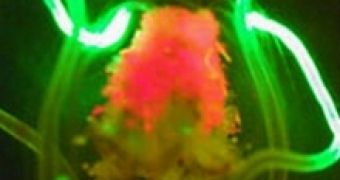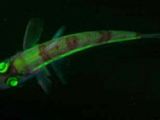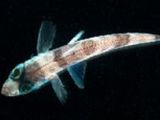Despite having to evade hurricane Katrina, a team of scientists from Harbor Branch and other institutions is returning to port this Sunday with new tales from the deep after completing their second annual Deep Scope expedition.
The group has discovered a mysterious visual capability in a deep-sea crab; captured new video of a large, recently discovered squid species; and took clear video of the world's first known fluorescent shark. The Commerce Department's National Oceanic and Atmospheric Administration funded the mission to sites around the Gulf of Mexico.
The expedition, which began Aug. 19, is taking place aboard Harbor Branch's Seward Johnson research vessel and the Johnson-Sea-Link I submersible, capable of diving to depths up to 3,000 feet. The mission's overall purpose is to use a variety of new technologies to gain a better view of deep-sea life, and to understand how that life itself views the deep sea.
Amidst calm seas, submersible dives resumed today and will continue through Saturday, Sept. 3, offering ample opportunity for additional discoveries.
"Considering that a category 5 hurricane just went through this area, I'm surprised that we can be out here and diving again so soon," says Chief Scientist Tammy Frank, a visual ecologist from Harbor Branch, "it really is astonishing how quickly the seas have laid down."
Frank has been conducting detailed studies of how the eyes of animals on the deep seafloor work, in collaboration with others aboard. Working with animals collected in special light-tight devices that avoid damage to delicate deep-sea eyes, Frank has discovered a species of deep-sea crab that can detect ultra-violet light, despite there being no known ultraviolet light in deep water. UV sensitivity is common in animals that live closer to the surface, but has never been discovered in a deep species. The reasons for this seemingly bizarre ability are not clear, but the sensitivity could point to a deep-sea light source about which researchers are not aware, or to some unknown characteristic of known light sources such as bioluminescence--the light chemically produced by countless open ocean organisms.
One key instrument used on the expedition to help humans see in the deep sea is the prototype Eye-in-the-Sea camera system, which was designed by Edith Widder, former Harbor Branch senior scientist who recently founded Ocean Recon in Ft. Pierce, Fla. This system is deployed on the seafloor using the submersible and left for 24-hour or longer intervals to film animals and activities using very low levels of infrared light virtually invisible to deep-sea animals. This allows an exceptionally sensitive intensified camera to capture natural behaviors and footage of animals that have evaded scientists that used other, more disruptive tools such as relatively loud ROVs and submersibles with their bright lights.
In the ocean, detecting fluorescence can allow scientists to spot animals that would otherwise be too effectively camouflaged to see. Fluorescence is also important because the proteins that allow animals to fluoresce are used in genetic research and new fluorescent animals may contain proteins that offer novel benefits in such work.
For more information and images, click here.
It's highly unlikely that among your favorite applications, there isn't an IM client. There's a broad offer, and even Google has entered the market. This week, Softpedia News is inviting you to choose your favorite IM client.

 14 DAY TRIAL //
14 DAY TRIAL // 

